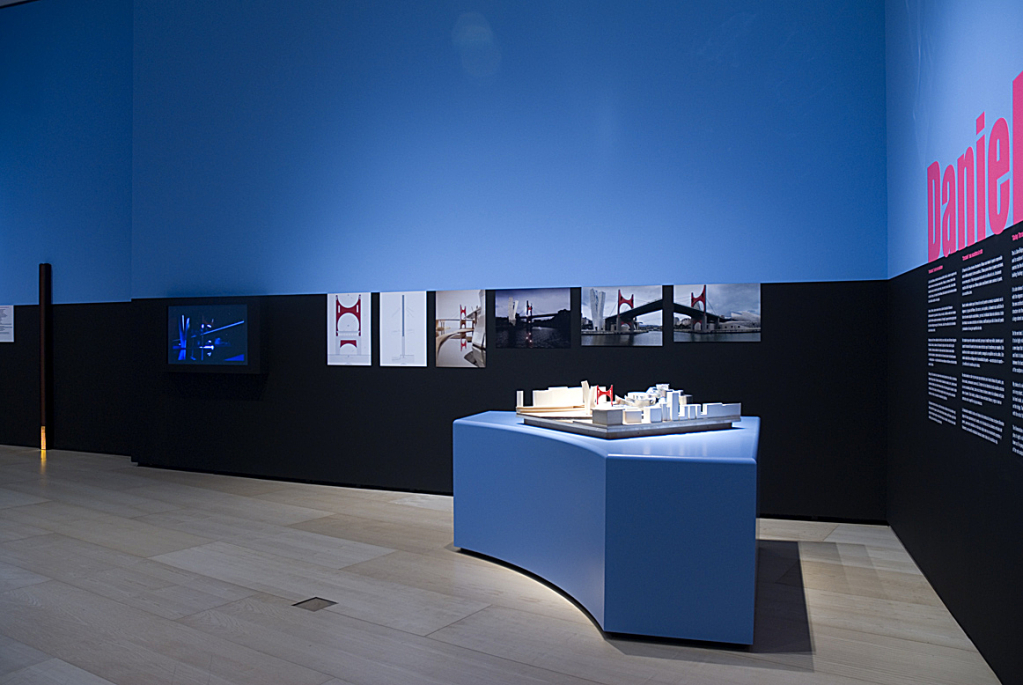La Salve bridge art project competition
10.19.2006 - 01.25.2007
La Salve bridge art project competition
In 2007 it was ten years since the Guggenheim Museum Bilbao was inaugurated, back in October 1997. To mark this event, the Museum commissioned an artwork for the citys La Salve Bridge, thereby adding to the Bilbao Collection a site-specific work conceived for one of the Museums most remarkable areas, while helping to enhance the citys general artistic heritage.
Models of the three projects presented by Daniel Buren, Liam Gillick, and Jenny Holzer are on display in the Museums 103 B gallery together with additional material to help the public understand how each individual project was conceived, while giving an insight into the three artists careers to date.
The final decision on the installation to be added to the Guggenheim Museum Bilbaos Collection was made public at the end of 2006. The Selection Committee included two representatives each from the Biscays Regional Council and the Basque Government. Also on the Committee are renowned Spanish architect Santiago Calatrava; Norman Rosenthal, Exhibitions Secretary at the Royal Academy of Arts, London; Thomas Krens, Director of the Solomon R. Guggenheim Foundation; and Juan Ignacio Vidarte, Director General of the Guggenheim Museum Bilbao.
But choosing the installation for La Salve Bridge was not a task for Selection Committee members alone. Given the scope of this eminently popular project destined to become a part of the city, the Guggenheim Bilbao feelt that its visitors should have a decisive role in the selection process.
Therefore, from October 20 to November 30 2006, all Museum visitors could vote for their preferred project. All they had to do is drop the card that they received with their admission ticket into the ballot box located next to their preferred project. That with the largest number of visitor votes had then an extra vote on the Selection Committee.
Once the Committee announced its verdict, the artist responsible for the selected proposal had several weeks to produce the definitive project, which was installed on La Salve Bridge during 2007.
Daniel Buren
Burens project is based on his conviction that the steel arch of the bridge is the only element that distorts the perfect harmony achieved by Frank Gehry between the Museum and the bridge, which is embraced and integrated into the buildings architecture. As Buren puts it, the arch "is not visually connected to the elegance of Museum."
So his proposal concentrates on transforming the structure of the bridge, covering it with a colored "skin", as a sort of sculpture, thus modifying the shape of the bridge without affecting its original function in any way.
For his sculpture, Buren has chosen a vivid red to create a sharp contrast with the bridges predominating green, while at the same time establishing a "chromatic connection" with the titanium scales of Gehrys building. The succession of black and white stripes on the edges acts as a counterpoint to the red.
The installation entails two types of lighting; one static that illuminates both sides of the "red sculpture"; the other a rather more dynamic, complex illumination located at the sides to give an effect of constant movement to the bridges internal and external edges.
Liam Gillick
Gillicks proposal for La Salve is very much in line with his previous work, which has been mostly designed to encourage dialogue and thought by acting as basis for discussion and exchange. Basically, the project seeks to integrate La Salve Bridge into the surrounding area, using a combination of light and shade that breaks up the sloping roadway without denying its existence.
He proposes to enhance the structure of the bridge by placing a circular structure on it bearing an equation from theoretical physics. The use of the equation parallels work he has done in the past, working with theoretical physicists in Ireland in 2000 and updating Gabriel Tardes classic eco-political 19th-century science fiction book Underground Man. The formula, which analyzes the impact of cities on the climate and the environment in general is, in Gillicks words, "a challenge for the viewer", one designed to push the level of communication that is expected from art.
A teacher at New Yorks Columbia University since 1997, Gillick often combines formal structures with conceptual devices. His proposal for La Salve is rounded off by a sequence of differently sized spherical forms lit from within and placed at intervals on both sides of the road on the outer part of the bridge, making it a point of attraction for the bridge and for the Museum itself.
Jenny Holzer
Based on the idea of a dialogue with landscape, history, and local culture, Holzers project for La Salve Bridge is also designed to convey and transmit Bilbaos new international profile. To make the movement around the river visible and "present from any angle in the city", Holzer proposes to install a series of LEDs under the bridge to cast amber light permanently onto the rivers surface.
Texts screened by the LED, running from the base of the bridge on the right bank to the opposite bank, where the bridges structure is seemingly integrated into the titanium of the Museum, would involve a program which incorporates fragments of works by Basque, Spanish and international poets in Basque, Spanish and English.
In addition to the LEDs, the proposal also involves a second feature. On one of the masonry elevator structures, and on a pedestrian walkway mid-bridge, Holzer proposes temporarily installing projectors to cast text in light onto the museum, the river, and the Artxanda hill, for special events. As part of the bridges renewal, the structure, including its underside, would be painted a soft silvery gray.
Partial view of gallery 103B; in the foreground, Daniel Buren’s project, which was finally executed

